Drop Time | January 17, 2021 19:39 UTC | 11:39 AM PST |
|---|---|
Mission Name | Demo-2, the launch of NASA’s Venture Class Launch Services (VCLS) satellites |
Launch Provider | Virgin Orbit |
Customer | NASA |
Rocket | LauncherOne |
Launch Location | Various. Cosmic Girl lifts off from Mojave Air and Spaceport in California |
Payload mass | 115 kg (253 lbs) |
Where did the satellites go? | Low Earth Orbit |
Did they attempt to recover the first stage? | No, this is not a capability of Virgin Orbit |
Where did the first stage land? | It crashed into the Pacific Ocean |
Did they attempt to recover the fairings? | No, this is not a capability of Virgin Orbit |
Were these fairings new? | Yes |
How was the weather? | It varies per location. Reported as “favorable” by Virgin Orbit on Twitter. |
This was the: | – 2nd test flight of LauncherOne – 1st flight for Virgin Orbit in 2021 – 1st time Virgin Orbit flies a commercial payload – Cosmic Girl’s 8,338th flight all-time – 1st air-launched liquid-fueled orbital rocket booster |
Where to watch | Virgin Orbit Mission Recap |
How did it go?
History has been made! For the first time ever, humans have air-launched a liquid-fueled rocket into Low Earth Orbit (LEO) on Virgin Orbit’s Launch Demo 2 mission! On January 17, 2021 at 10:50 AM PST, the 747-400 Cosmic Girl lifted off from the Mojave Air and Space Port to take LauncherOne out over the Pacific Ocean to later be released and launched. After the rocket was released, its first stage NewtonThree engine fired and then shut down a few minutes later without fault. Following the shutdown, stage separation occurred with a nominal firing of the second stage NewtonFour engine.

From Virgin Orbit president and CEO Dan Hart, “Even in the face of a global pandemic, we’ve maintained a laser focus on fully demonstrating every element of this revolutionary launch system. That effort paid off today with a beautifully executed mission, and we couldn’t be happier.” After all stages of flight were completed, the 10 CubeSat payloads were deployed successfully.
Launch Demo 2’s Payloads
A total of 10 CubeSats were launched on LauncherOne for the Demo-2 mission, which are all part of NASA’s Venture Class Launch Services. NASA’s VCLS is enabling the 20th Education Launch of Nanosatellites mission (ELaNa 20). This program allows students to design, build, and operate small payloads to learn and conduct their own experiments. So far over 250 students have been reached with many more to follow.

CACTUS-1
CACTUS-1 consists of two 3U CubeSats built by undergraduate students from the Capitol Technology University, Laurel, Maryland. TrapSat will use aerogel to catch and collect micro debris, which has the potential to damage other spacecraft.

CAPE-3
CAPE-3 will serve two main purposes. First, it will enable grade-school students to access the satellite and perform an experiment in a simple way: a ground-station that can be self-assembled. Once the ground station is connected to the network, it can be accessed via a cellphone. After that, students can perform their own experiments and gather their own data. The satellites’ secondary function is Earth imagery and radiation detection.

EXOCUBE-2
ExoCube-2 aims to monitor and study atomic and ionic substances in the exosphere to better understand how they might affect space weather and satellite communications. To do this, ExoCube-2 will measure the density of hydrogen, oxygen, helium, and nitrogen.

MiTEE
MiTEE aims to demonstrate the electrodymic teather technology which will enable the linking of these tiny satellites, which will be cheaper to launch, but still be able to preform accurate Earth and space weather observations. These satellites are called pico and femtosats and will work together as part of a large network.
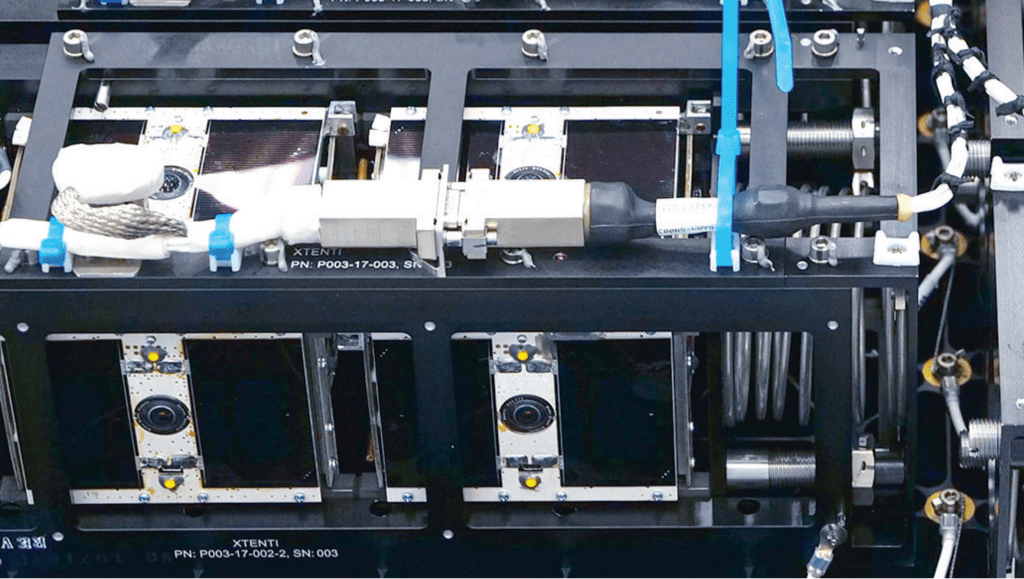
PICs
Consisting of a pair of CubeSats, PICs will assist other satellites with repair and maintenance while being able to return images of other satellites to Earth via a flyaway probe. The probe will safely take images of the satellite from all angles. Once these satellites are proven, they will be integrated onto larger satellites which will deploy them when necessary to take those external images.

PolarCube
Using its small radiometer and in combination with the SMAP satellite launched in 2015, PolarCube will observe Earths poles’ ice sheets and collect atmosphereic temperature data.
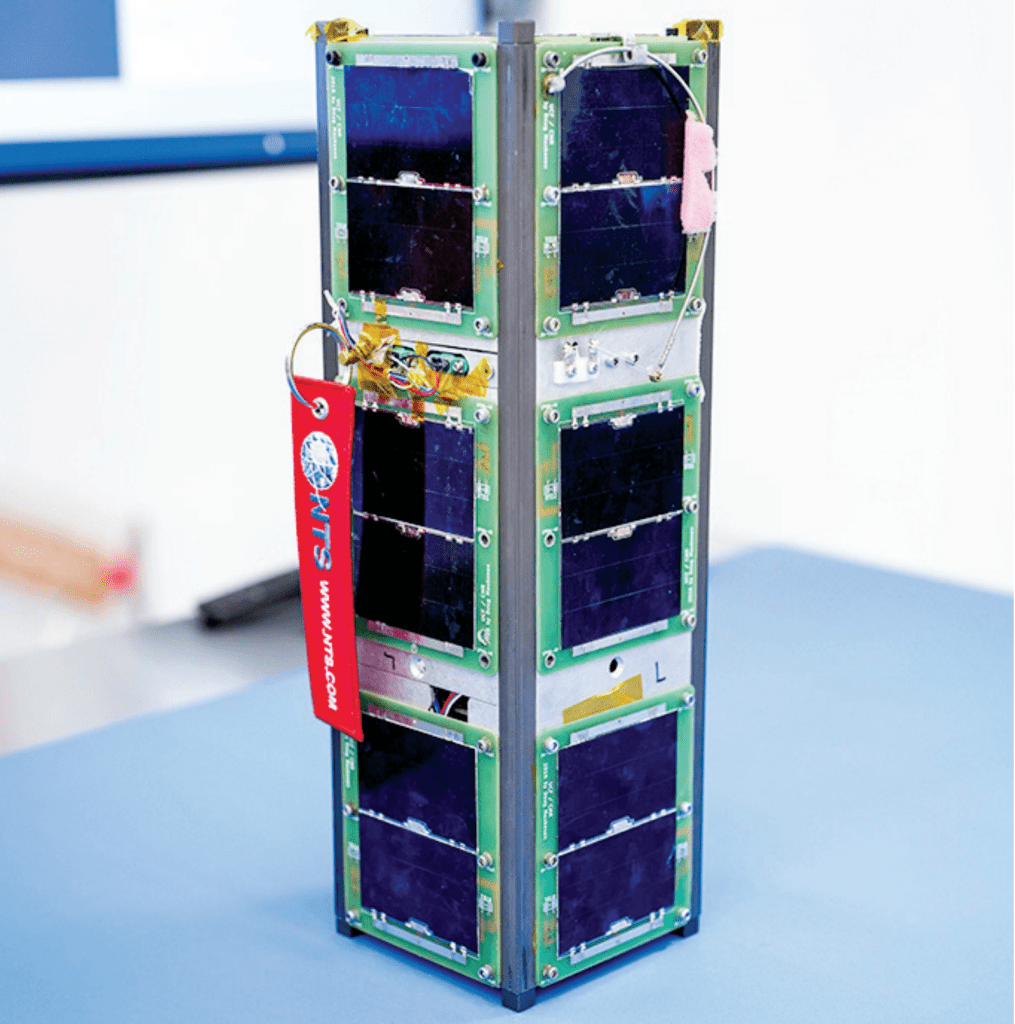
Q-PACE
This three-year mission will aim to study the outcomes and physics of microgravity collisions. Starting on a centimeter and smaller scale, Q-PACE will observe the early disk and particle clustering the begins in the early stages of celestial body formation.

RadFXSat-2
The main goals of RadFXSat-2 are to observe the effects on various microelectronics, such as RAM, from solar radiation. All of the data from this short experiment will be transmitted by way of amateur radio, a low-cost way of communications.

TechEdSat-7
This satellite will test new CubeSat technology by using the “ExoBrake” when it re-enters the atmosphere after 60 days in orbit. “ExoBrake” is a device that will increase aerodynamic drag to help slow down the satellite. The goal is to decrease satellite reentry time from a 500 km (310 miles) orbit from years to just 6-8 months. Researchers try to achieve that by using a high-efficiency drag device.
Launch Demo 2’s launch sequence
After Cosmic Girl reaches 10,600 m (35,000 ft) of altitude, the pilots pitch the plane upwards at a 27° angle. Then, controllers give the launch command (hitting the Big Red Button) from the “first-class” Mission Control. This triggers the launch sequence that ensures that there is no accidental jettison prior to the actual commanded launch.
Launch
The red pylon contains 3 hooks that detach from the rocket, letting the rocket fall. After about three seconds of free-fall, the propellant settling thrusters ignite, followed by the NewtonThree engine firing. After a few minutes, it has increased its velocity to about 12,870 km/h (~8,000 mph). The first stage then separates from the second and breaks up in the atmosphere following a balistic trajectory.
Stage Separation
Shortly after stage separation, the second stage’s NewtonFour Engine ignites. It propels the payload the rest of the way to orbit. Depending on the flight profile and mission, the second stage will perform two or three burns for a controlled deorbit, or to increase performance. Once the rocket is out of the thickest parts of the atmosphere, the fairing halves will separate and fall back into the ocean, since they are no longer needed to protect the payload.
LauncherOne
LauncherOne comprises of two stages. To start off, the first stage which houses RP-1 or rocket fuel and liquid oxygen or LOX. These two will mix and power the single NewtonThree engine, which is capable of 327 kN (73,500 lbf) of thrust. Near the fins of the engine, there are two Propellant Settling Thrusters (PSTs) and they do exactly what you would expect. They ignite just seconds before the NewtonThree engine does, to force the propellants to the bottom of the tank so the engine doesn’t take in any air. This is not commonly seen on the first stages of liquid-fueled rockets, since they take off vertically. However, they are very common and almost necessary on the proceeding stages.

The second stage is much smaller and has a single NewtonFour engine, which is also propelled by RP-1 and LOX. This engine has the capability to relight and can only produce 22 kN (5,000 lbf) of thrust. The difference between each engine is minimal since LauncherOne is already at around 10,600 m when its first stage ignites. Therefore both engines need to have a larger engine bell than if they were at sea level.
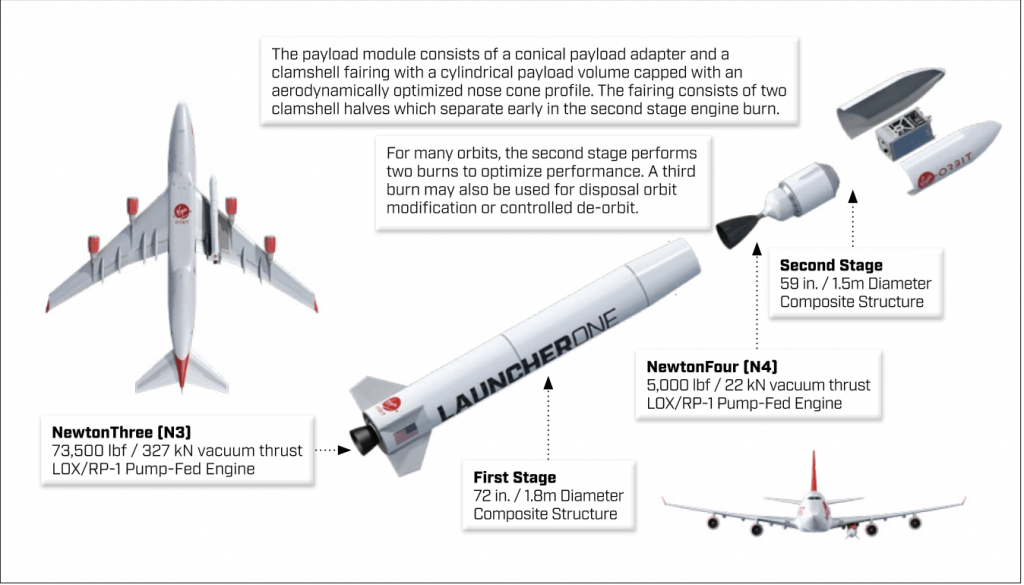
How does LauncherOne compare to other rockets?
The only other place where one might find a set of events similar to LauncherOne’s is Northrop Grumman’s Pegasus launcher, which also starts underneath a plane. In particular, a Lockheed L-1011 TriStar aircraft named Stargazer. Pegasus has launched a total of 44 times with 39 total successes.
How do Pegasus and LauncherOne differ?
Visually, they are both fairly similar. They have the familiar rocket shape (flamey end and a pointy end) and both have fins. However, Pegasus has a wing near the midsection of the rocket. This is for enhanced stability specific to the structure of Pegasus.
| LauncherOne | Pegasus | |
| First Stage Engines | 1 | 1 |
| Stages | 2 | 3 |
| Payload Capacity (LEO) | 500 kg (1100 lb) | 443 kg (977 lb) |
| Launch Platform | Boeing 747-400 (Cosmic Girl) | Lockheed L-1011 TriStar (Stargazer) |
| Liftoff Location | Mojave Air and Spaceport, California | Varies (Florida, California, Pacific and Atlantic Oceans) |
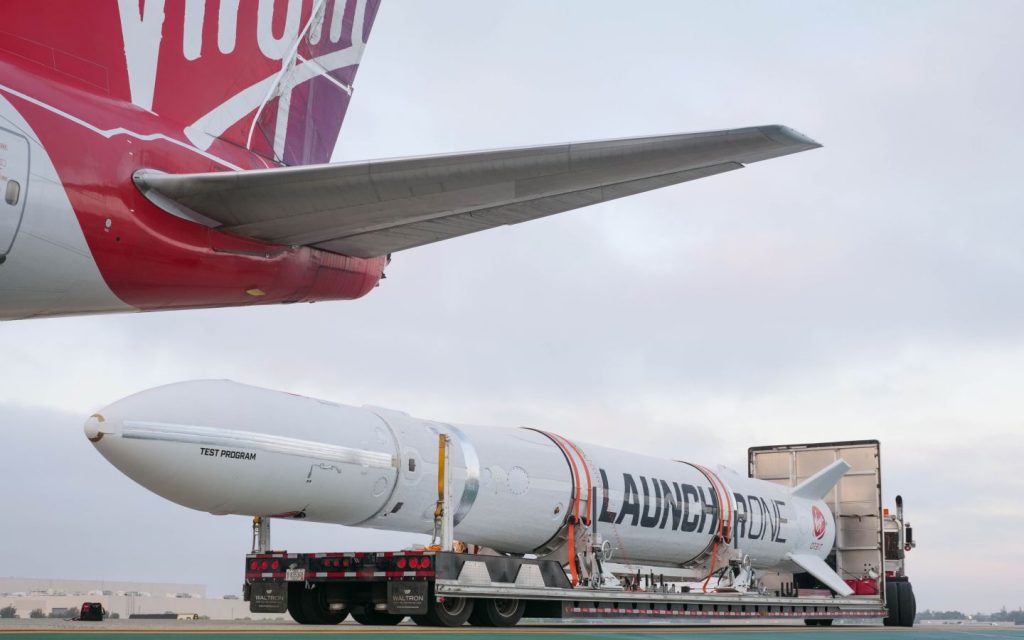
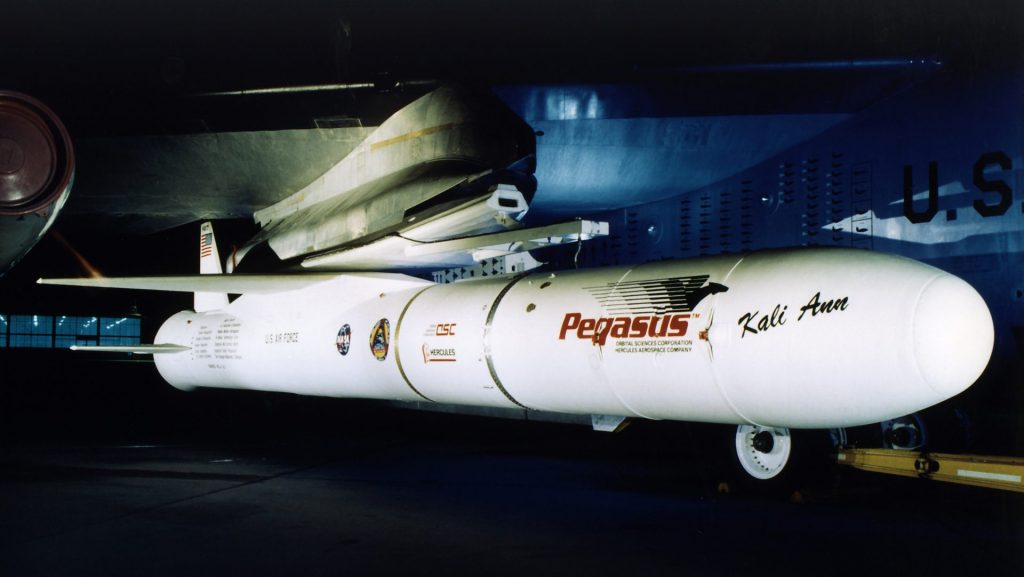
Why Air-Launch?
The ability to air-launch is a tremendous advantage for multiple reasons. If the weather is bad in one area, the plane can fly to another area with calmer skies. Some other advantages include a reduced amount of fuel, an altitude and velocity increase, which will already have taken it out of the denser parts of the atmosphere.
However, there is one major disadvantage. Weight. Because Cosmic Girl can only carry so much weight, and fuel is heavy, Virgin Orbit reduced the payload’s weight. That means the maximum payload to LEO is 500 kg and to Sun Synchronous Orbit (SSO) is 300 kg.

On the other hand, this weight limitation does not impede Virgin Orbit’s principal mission. Their goal is to make space available to everyone. Since the CubeSat industry is expanding, there is room for yet another launch vehicle in the small sat launcher class. They will be capable of providing a cheaper way to launch small satellites for universities and STEM programs.
What happened to the first test flight?
On May 24, 2020 Virgin Orbit attempted their first ever flight over the Pacific Ocean. The hours leading up to the flight were right on schedule as the Virgin Orbit team worked through each step of the checklist to proceed to their flight time. Cosmic Girl took off from Mojave Air and Spaceport in California and climbed to its cruising altitude of 10,600 m (35,000 ft).
LauncherOne was released and performed its 4 second free fall perfectly. However, at about 5 seconds after ignition, an automatic abort was triggered causing the NewtonThree engine to shutdown. The failure was caused by rupturing of the LOX feedline, which feeds liquid oxygen to the NewtonThree engine. Since the last test flight, Virgin Orbit teams have matched their models to the flight hardware and made the correct modifications to ensure that this failure does not occur again.
It is very important to note that despite LauncherOne not making it into orbit, the Virgin Orbit team still gained an immense amount of data from the short flight. It was labelled a “Test Flight” for a reason, to test the different rocket systems. For Launch Demo 2, teams have reviewed the data from the first test flight and are confident that the mission will be successful.
Below is Virgin Orbit’s video recap of their first test mission:





